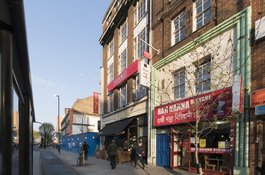14 Whitechapel Road, including the George public house and the early history of adjoining buildings
Contributed by Survey of London on June 27, 2016
A timber-framed building on this site by the early eighteenth century was the
George Inn, which, with livery stables to the rear, was inherited by William
Fillingham in 1749. Charles Fillingham was making saddles and harnesses here
around 1800, John Fillingham (1763–1817) had the freehold of the house at No.
12, and later Fillinghams continued to make saddles at 8 Whitechapel Road into
the 1920s. The George Livery Stables were run by George Starkins Wallis from
around 1815 into the 1850s, and then by Charles Webster Ltd up to 1913.
Some of this frontage had been recently rebuilt in 1770, possibly including
the site of Nos 10–14. The most westerly house by the rectory was where John
Henry Prince, later to achieve modest fame as a Methodist writer, was born in
1770. By 1750 Richard Whiteshead, a coachmaker, was established to the east of
the George. He was followed by James Exeter, then William Hammer and his
descendants from around 1810 into the 1840s at what became Nos 20–26. The
sugarhouse behind the site of Nos 28–30 was first run by John Brissault from
around 1736, then by James Lewis Turquand from about 1765. It passed to George
Wolrath Holzmeyer in 1779, and then in 1799 to William Wilde, who, it appears,
had by 1805 built a new sugarhouse on a larger and deeper rectangular
footprint on the site that was later that of the Bell Foundry’s back workshop.
John Henry Wagentrieber ran this sugarhouse by 1812 up to about 1827 after
which it may have been demolished.
The pub, called the George and Dragon by 1841, was rebuilt in 1881–2 for
Courage & Co. Ltd by Ashby Brothers, builders, and its name changed again
to the Old George. But the licence was lost and the premises converted to shop
use by 1914; there were partial rebuilds in 1923 and 1927. These were followed
in 1934 by the insertion of a two-storey faience-trimmed neon-embellished
shop-front, designed by North, Robin & Wilsdon, architects, and made by
Crabb & Son Ltd of Tulse Hill. This was for Boris Bennett (1900–1985, born
Sochaczewska in Poland), who traded as Boris Studio and became ‘the doyen of
Jewish wedding photographers’. The building was acquired by Buck &
Hickman Ltd in 1952, when first-floor windows were inserted, and is presently
occupied by Haji Nanna Biryani with flats above.
Boris the photographer
Contributed by Joe Swinburne on June 12, 2017
Every Jewish house had the wedding photograph. The only thing that was
different if you were to pick ten or twelve houses with these wedding
photographs were the faces of the people. Everything else was identical.
